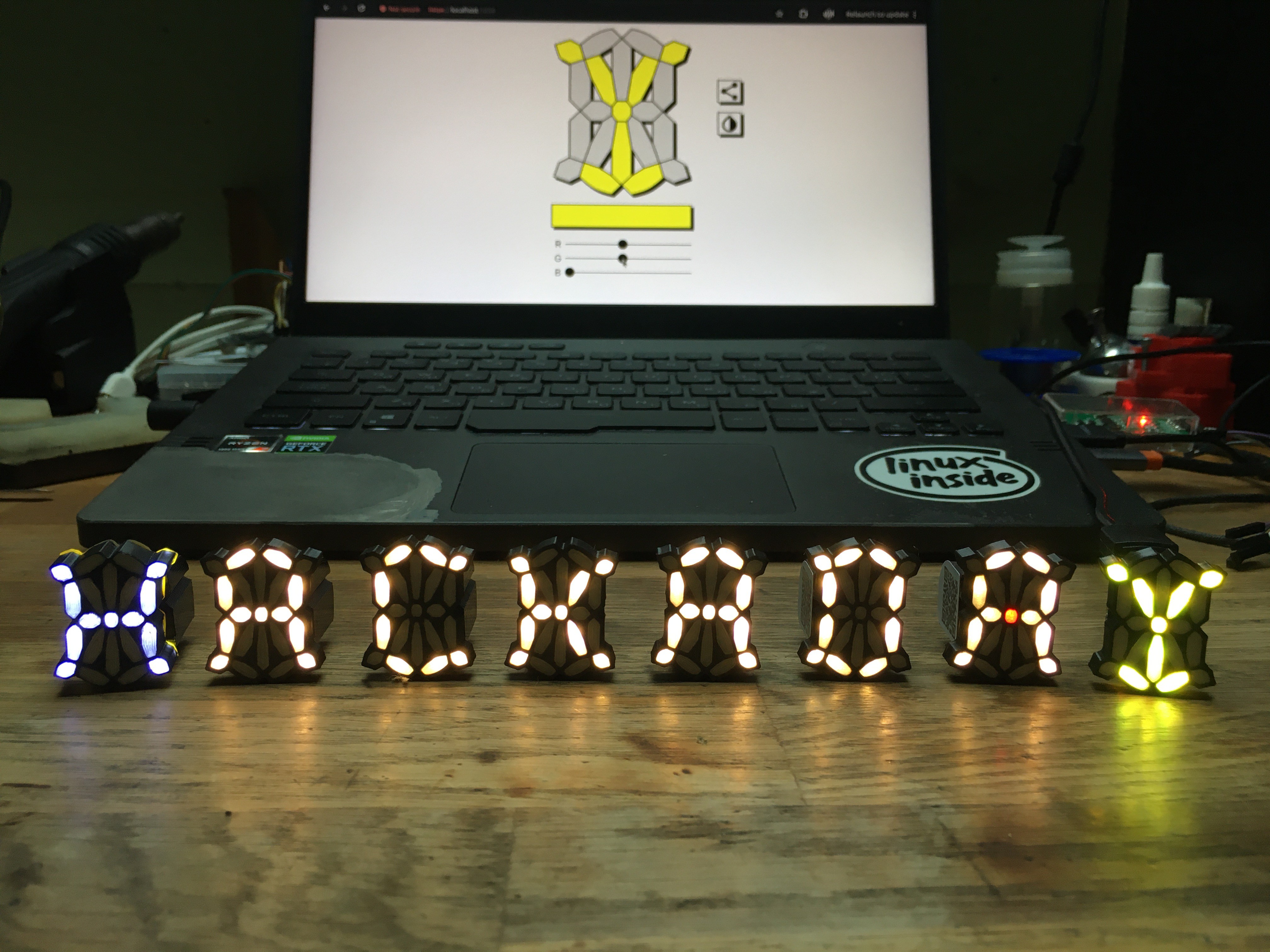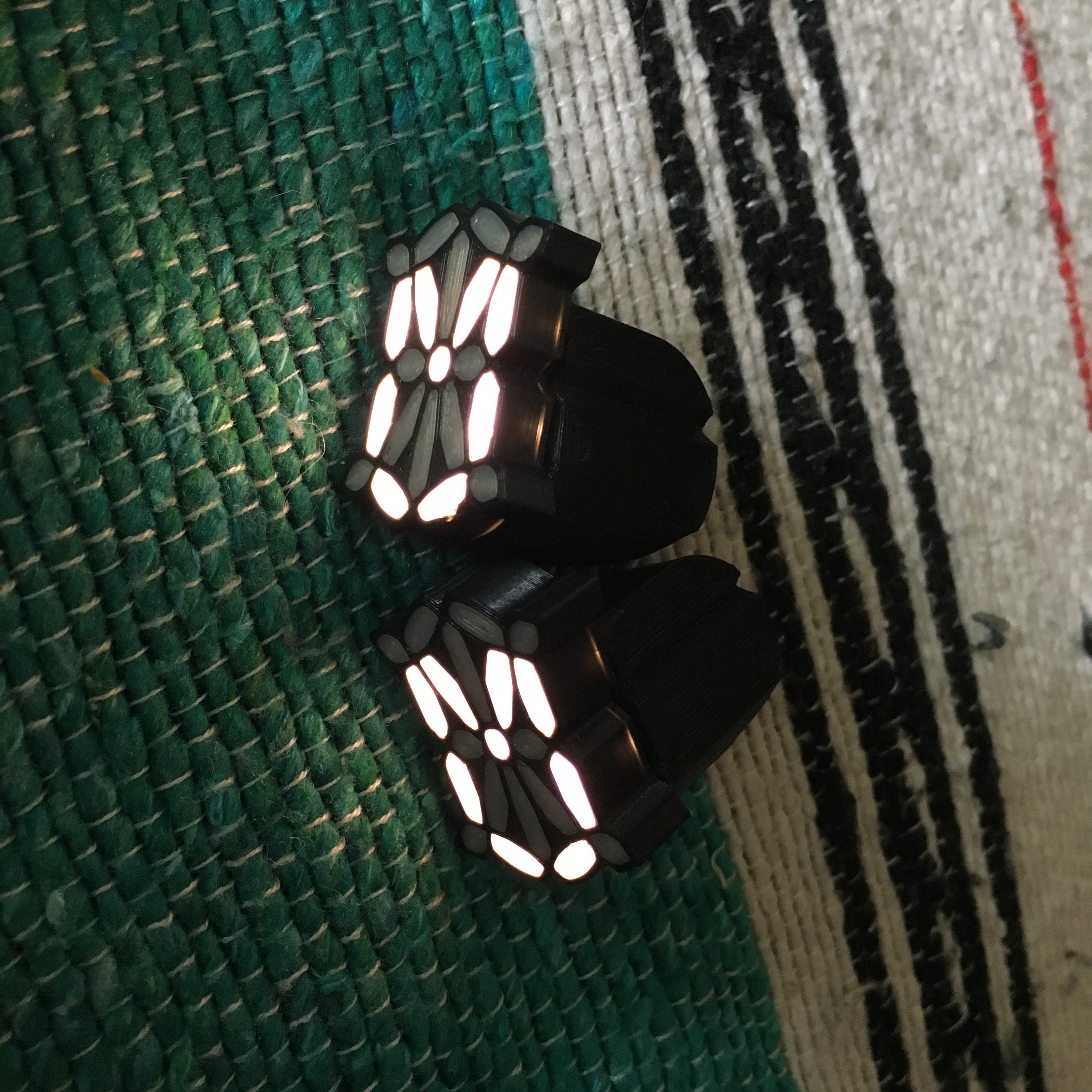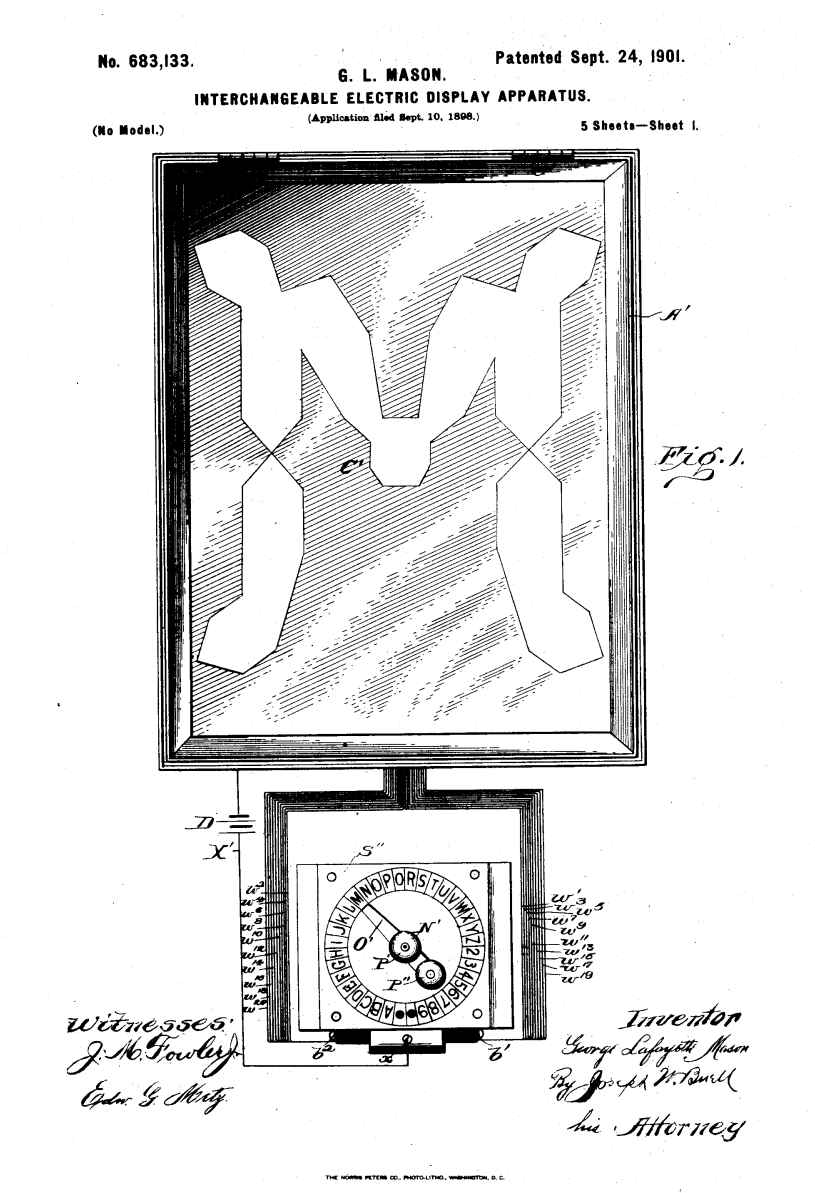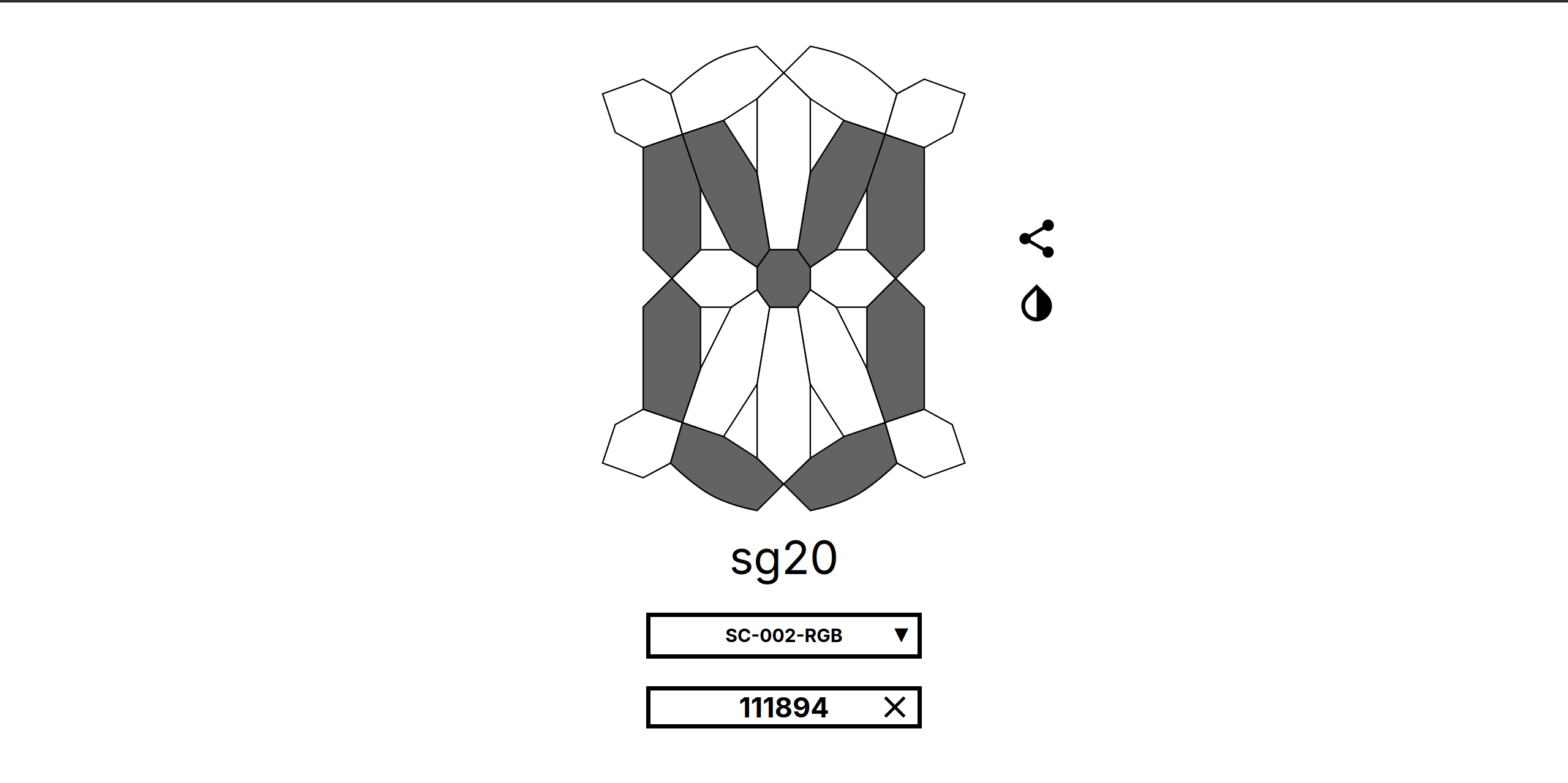-
HACKADAY
11/10/2024 at 12:55 • 2 comments -
Supercon 2024
11/04/2024 at 15:04 • 1 commentThanks to @davedarko's comment on this project's page I had a chance to show my ongoing project at Hackaday's exhibition of weird displays.
I had many concerns about shipping to the other side of the world, but thanks to Willmore displays arrived just in time and he also kindly uploaded a new firmware that I was finishing at the last moment for the show.

And then at the show itself @CNLohr saved the day and set the display the right way and also took photos and videos of the whole stand and this beauty in particular :)
Thank you all wonderful people who made this possible! Participating in Hackaday's Supercon even in such small capacity wasn't on my list, that's for sure. But I am very glad that this happened. -
More prototypes
11/02/2024 at 08:33 • 0 commentsOnce I confirmed that this thing could work and it looked pretty interesting it was time to fix minor mistakes I've made in the first board and also draw a PCB that would have addressable RGB LEDs, USB, and some headers to stack it in multiples. That was the idea from the beginning but I wanted to move incrementally because I guess everyone knows what it feels like when you dream a big project but after initial testing realize it isn't that promising, but you already ordered parts/boards/made promises :)
Anyway, now I had two versions of the display, one is mostly the same as the first prototype, but with fixed routing and the second with all the bells and whistles that I could fit on a board of that size.
SC-002-C RGB version required more GPIOs to have all the features I wanted. The nice thing is that CH32V003 exists in so many different packages, and my favorite is 20-pin QFN (some people think that I must hate myself as a reason for choosing it). Another great thing (it may very well be the best one) about the whole CH32 thing is ch32v003funproject. I'm not sure if I ever would become brave enough to use the official SDK for these chips. Even though not everyone agrees to call it fun dealing with Makefiles, heavy reliance on #define statements for every second feature, and requirement to have a reference manual for the chip you are working with, I think it's the next best thing after you got acquainted with Arduino. Also if you hate (scared of) STM HAL, or can't wait an eternity to recompile and flash your ESP32 project every time you have changed an argument in a function, ch32v003fun can give you something you've been craving for. It makes working with registers easy by extensively documenting everything and providing a vast amount of examples of their usage. It also compiles in seconds and flashes your MCU even faster with a single press of a button! :D The first few times you may think it didn't do anything but then you see your LED blinking, and wonder, why no other framework can work so fast.
Sorry for getting too lyrical and all. Have I told you that there is also a bit-banged USB stack for this 10 cents MCU?! Yeah, there is one, and it even has a working bootloader - rv003usb.
So, that's it, we have 21 WS2812 compatible LEDs, USB Type-C port, two headers to daisy-chain multiple displays and communicate between them via UART or I2C. And also a switch, that will help us enter the bootloader and do some interactions in standalone mode.

SC-002-RGB The actual LEDs have different (smaller) package, but they are compatible with the 2020 footprint of WS2821B, headers are also missing because they are somewhat special and I couldn't find a 3D model, and couldn't be bothered with making my own, but I'll show you the picture:

I've ordered 10 of each boards and after some time I had everything ready to do some soldering:
Also while waiting for PCBs to arrive I've printed more light diffusers and decided to make them thinner.

And after soldering I had something to gift to my friends and people who helped me to start this project in the first place.
Yeah, I've also made a simple battery packs with two CR2320 as an afterthought My friend liked it so much that he filmed a nice motivational video for me :)
Next time I'll finally tell you and show what I've been doing with RGB version trying to fulfill my initial vision.
While you are waiting you can take a look at this github where I uploaded single-colored version and soon will add the RGB one, and also now this project has it's own little web page here: https://subjectiverealitylabs.com/SC002/
-
Alphabet
08/31/2024 at 14:42 • 0 commentsI had a working prototype, and charlieplexing worked, almost as intended. One part that was missing was the font. George Mason omitted this part in his patent, so we don't know how it was supposed to look, except maybe for one letter - M.
---------- more ----------Anyway, when I first saw this design, I was surprised by the potential variability it proposed for making fonts for it. It had serifs! But also you could make a sans font, several variants of numbers, and even a full Cyrillic alphabet if your heart desired.
The only thing that was needed was some kind of a tool to be able to design the glyphs and translate them to a suitable format for use with limited resources of CH32V003. In the firmware, I decided to store every glyph as a 32bit integer, where every bit from 0 to 20 signified a corresponding LED in a chain. To make a font and convert it to an array of bytes I created a simple web tool where you can turn segments on and off and will get a number that represents the glyph you've created. Then I also added the ability to share your creation as a link, because I wanted to send some funky (or goofy really) letters to friends.The looks and functionality are going to improve because I want to be able to compile a full charset and maybe export it as a rasterized sheet (or even better, as a real font file).
You can try the tool and see if you like the letters that this display can produce, or maybe find some symbols that are beyond known alphabets and are only possible with it.
-
Inception
08/27/2024 at 10:57 • 0 commentsI watched a TechnologyConected video about the Numitron 7-segment displays. In the beginning, Alec showed the first variants of the now ubiquitous segmented displays. He mentioned a patent by George Mason dated 1898 and said that though it was the true alpha-numeric display the font it produced was "creepy". I love font design, calligraphy, and everything about letters and I was definitely against such a harsh description. I thought the font and the display itself as it was described in a drawing was beautiful! Anyway, I sent a link to the patent to a friend who happens to be a graphical designer and asked if I was wrong thinking that this thing has potential as a font. He said that it definitely looked interesting and unusual and later that day sent me a mock-up in figma where you could switch segments on and off and make letters. I was amused by this and though I had other projects to work on I thought it would be pretty simple but cool to bring this display to life.
(Later I was informed that someone already did this very thing (of course they did) so even though my project has slightly different goals and idea, I can't not mention them here. The first one is Resurrecting 21-Segment Victorian Displays by Max Maxfield. And another one is a collection of segmented fonts and an easy way to test them in your browser by Marcin Wichary.)
 ---------- more ----------
---------- more ----------So I asked him to share SVG of the segment's outlines so I could tinker with it. Then I made a quick sketch in Fusion to better imagine what it might look like IRL.
I went to @CNLohr's discord server and asked if anyone had an idea how to better achieve this and later had a good brainstorm with Willmore and other participants of the weekend's meeting. In the end, @CNLohr convinced me that it was not worth trying to do multiplexing with added parts like a shift-registers or another V003 and that addressable LEDs barely cost anything more considering total BOM.I have a natural anxiety about ordering PCBs overseas unless the thing is somewhat worked out beforehand in some form of a prototype. Also, it's easier for me to make 1-2 prototype PCBs at home than order 5-10 > wait 2 weeks > receive them be busy with something else, and come to actually assembling them months later.
I decided to do a trick and drive two segments in parallel but then I forgot to pay attention to the placement of those 2 particular LEDs.
They ended up in the wrong segments, which if driven together didn't make any sense for the font. So I had to disconnect one of them that makes a diagonal part in some letters.
And that's exactly what every second person was pointing out in the comments when I uploaded a video of a prototype to youtube:I guess, that's a good way to bump up the numbers of comments. Just make a simple mistake and pretend you haven't noticed :) (I bet all those streamers on twitch do it every time)
 monte
monte











